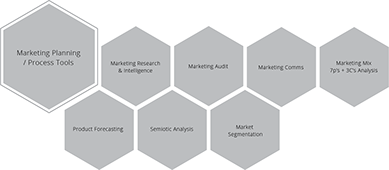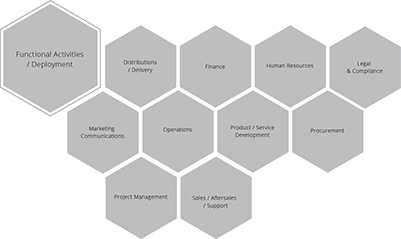Glossary
Logout
©Copyright Arcturus 2022, All Rights Reserved.
7
Terms & Conditions
|
|
|
|
Security & Privacy
Contact
MARKETING COMMUNICATIONS
|Introduction
Marketing Communications is a key element for creating and maintaining product awareness. The product ethos and message (whether it is internal or external to the target market) has to be managed and orchestrated with some degree of precision.
All promotional actions must be carefully evaluated and planned if they are to stand any chance of success.
Marketing Communications ~ Rationale
- Category needs – the perception of the actual customer needs
- Brand awareness – the ability of the consumer to identify and associate with a particular brand
- Brand attitude – this relates to the consumer’s particular observations, view and perceptions of the brand, cognitive beliefs
- Brand purchase – once the category needs have been identified, the brand purchase intention follows
- Purchase facilitation – the organisation needs to ensure the product is in the right place, at the right price, at the right time
Purchase Decision Steps
Understanding the customer / purchaser and their thought and decision process when making a purchase is of great benefit when designing a communication strategy.
The diagram below indicates the steps that purchaser will map through perhaps unconsciously.
Purchase process definition;

In the majority of cases advertising requires a dedicated program of events to constantly reinforce the message. Typically it utilises a ‘high’ profile medium to communicate the message and the associated costs can be extremely high in relative terms.
Promotion relates to specific incentives designed to stimulate the purchase / sale of a product, usually in the short term. This is achieved by using a combination of methods designed to be more controlled and opportunistic than advertising alone.
Advertising and Promotion activities are directly related to the Marketing mix and as such form an important strategic element.
There are four main aspects of the Promotional Mix. These consist of:
- Advertising:‐ Any paid form of presentation and promotion of ideas, goods, or services.
- Personal Selling:‐ A specific and targeted approach of persuading prospects to purchase a
product or service.
3. Sales promotion:‐ Incentives designed to stimulate the purchase or sale of a product, usually
in the short term.
4. Public relations:‐ Stimulation of demand for a product, service, or business unit by
(strategic) reporting significant news about it or a favourable presentation of it in the media.
Marketing Communications ~ Scope
Communicating the product message to the appropriate target audience will require a range of tools and techniques which must be deployed in the appropriate manner. It should be noted that ‘Marketing Communications’ is not a single process as such but a collection of tools and techniques for managing the marketing message.
The following should be appropriately addressed as part the marketing communications plan:
- Product Name / Identity
- Product Advertising and Promotion
- Personal Selling
- Direct and Interactive Marketing
- Public Relations (PR), Press Releases
- Brand Management
- Sponsorship
- Publicity ‐ Product Technical Leaflets, Application Notes, Market Sector Solution Plans,
White Paper
9. Product Packaging
10. Exhibitions and Conferences
11. Product Incentives
The effectiveness of any communication programme / activity is influenced by;
1. The idiosyncrasies of the target market.
2. Any psychological techniques employed...
3. The perception of product qualities
4. Specific views from opinion formers, role models and critics
5. Word of mouth recommendations...
6. The overall receptiveness of the target audience.
7. The level of product uniqueness.
8. Initial brand awareness.
|Marketing Communications Objectives
Marketing Communications strategies can be expensive to execute in totality, so it is of paramount importance that clear objectives are determined, they could include;
- Clarification of customer needs
- Increasing brand awareness
- Increasing product knowledge
- Improving brand / product image
- Increasing brand / product preference
- Stimulating search behaviour
- Increasing trial purchase
- Increasing financial position
- Increasing flexibility of the corporate image
- Increasing cooperation from trade
- Enhancing the reputation of the product / organisation
Marketing Communications Strategy
In developing the communications strategy you need to take into account the following;
1. Corporate Vision and Beliefs ~ Strap line.
2. Product Vision.
3. The expectations of the target market.
4. The short, medium and long term communications objectives.
5. The message... what needs to be communicated?
6. The communication channel/s used to carry the message.
7. The available budget.
8. The Promotions Mix.
9. Integration with other plans and associated products.
The scope and purpose of this element is to identify `the advertising and promotional’ activities that are required for the product. Internal and external communication programs (advertising, promotions, special brochures, incentive schemes, product launches etc) should be detailed in this section.

|Strategy and Methods
Sales Promotions
Sales promotions are a range of tactical marketing techniques to add value in order to achieve specific sales and marketing objectives.
Objectives might include:
• To stimulate trial
• To level out demand fluctuations
• To increase usage
• To encourage trading up
Advertising and Promotion Principles
Advertising and Promotion is used to reach and communicate the product attributes to the target market. The primary role of Advertising and Promotion is to;
1. Differentiate
2. Remind
3. Inform
4. Persuade
Extensive advertising is extremely powerful and creates confidence in the product and the desire to purchase. This series of emotions is known Mnemonically as AIDA :
1. Attention
2. Interest
3. Desire
4. Action
Campaign Planning Overview
A successful advertising and promotional program relies heavily upon a clear understanding of what needs to achieved together with an appropriate set of measurable objectives. Without clear vision and direction from the outset the program will almost certainly lead to inefficient and ineffective results.
It is therefore of paramount importance that the Product Manager sets an appropriate set of objectives followed by activity planning, implementation and control.

Define the Target Market / Audience
In developing a promotional campaign the following needs to be considered:
• What is the role of advertising in this campaign?
• Who is the target audience?
• What is the unique selling proposition?
• Why should or do people want to buy the brand?
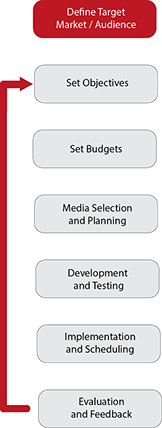
It is important to define in some detail what the target requirements and purpose of any advertising.
The compilation of the advertising plan provokes a number of questions to be asked:
- Who is the target audience? What do we know about them? What kind of customers are they, etc.?
- What response do we want to achieve? What do we want to say, convey, make them feel, believe or understand, etc.?
- How are we going to proceed? What is our creative platform? Can we be sure this is appropriate?
- Where is the best place to put our communications? Will it be cost‐effective? Does it generate the right image, etc.?
- When will our communications be displayed? Is this the best time? Does it mesh in with other activities, etc.?
- Result – what do we expect to achieve? How will we measure this? Does it mesh in with other activities, etc.?
- Budget – how much is needed? How much is going to be available? How will it be controlled, etc.?
- Schedule – who is going to do what, where and when? What is being spent on what, where and when?
Advertising and Promotion Objectives
Advertising and Promotion objectives define awareness and attitude goals as they relate the target market. Subsequent advertising strategies describe the necessary method to fulfill the advertising objectives.
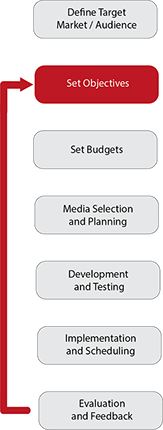
There are many possible alternatives to be considered when defining the advertising and promotion objectives and they may include one or more of the following:
- To bring a prospect closer to a sale
- To change customer perceptions
- To direct customer action
- To support the sales force
- To reinforce attitudes of existing customers
- To open up distribution
- To improve company image
- To demonstrate the product capabilities
- To generate enquiries
- To impart information
- To reassure customers
- To ‘score points’ off competitors’ advertising
- To enter new markets
- To give reasons for buying
- To create awareness
- To support retailers
- To convey the idea of ‘value for money’
- To establish an immediate sale
- Educating the market
- Increasing product/service usage
- Reminding/reinforcing
- Reducing demand fluctuations
- To convey information
- To alter perceptions
- To alter attitudes
- To create desires
- To establish connections,
- To direct actions
- To provide reassurance
- To demonstrate
- To generate enquiries
- Promoting products, organisations and services
- Stimulating demand for products
- Increasing sales growth
The foundation for setting advertising objectives is the fact that awareness leads to an attitude formation, which leads to behavior. In most purchase situations, you can't have an increase in purchase behavior until there has been a positive shift in attitudes about your product. And increase in awareness of your product and its communication is a prerequisite for shifts in attitudes. Therefore, advertising objectives focus on increasing awareness and establishing positive purchase attributes as determined by the target market.
Advertising and Promotion Budget
Prior to launching and or committing the company to an expensive advertising / promotional campaign it is important to determine the available budget. The budget will ultimately determine the type and duration of the advertising.

Advertising and Promotion Strategy
The advertising and promotion strategy is the catalyst of effective advertising. It provides direction on what should be communicated in the advertising message and how it should be communicated.

Prior to launching and or committing the company to an expensive advertising / promotional campaign it is important to determine the available budget. The budget will ultimately determine the type and duration of the advertising.
is a big part of the means that gets the desired product perception into the mind of the consumer. This strategy is the guide for development of creative and communicative advertising in order to gain attention, be remembered, positively affect attitudes, and help move the target market to purchase your product. It becomes a guide for those who will actually create the advertising.
Further, the advertising strategy describes the personality of the advertising and the parameters of the creative environment in which the advertising must perform. Without this guide, the final advertising could very well be exceptionally entertaining but not necessarily effective. The advertising strategy is not only a guide for creative development but also the basis against which creative work is evaluated to make sure that advertising communicates effectively. Usually you want to develop alternative creative approaches (copy, layout, storyboards, etc.) against the agreed upon advertising strategy and then judge the best approach to execute the strategy.
Also, if you are having an advertising agency execute the creative, both the client and the agency should contribute and mutually agree to the written strategy before it is executed. This strategy agreement is necessary so that when the advertising work is presented, there is no confusion or disagreement in terms of the description of the product, specific benefits, claims made, and feeling of the advertising. Further, having an agreed upon strategy up front will save time in creative development and help eliminate frustration for all involved.
The advertising strategy should include the following:
- Offer: Define the reward/benefit for the target market in solving a problem or taking advantage of an opportunity.
- Support for this Offer: Give substantiation for the promise or reasons to believe.
- Tone of Voice: Describe the feeling of the planned advertising that is consistent with the personality of the product. The tone must be appropriate not only for your product but also for the target market of the advertising.
Look to the ‘product positioning statement’ for direction when writing strategy, because it will be the key in developing an advertising strategy that will differentiate your product from the competition. Make sure your advertising strategy speaks directly to conveying the image you want to instil in the minds of the target market.
Each word in your advertising strategy is critical; Make sure it communicates the intended meaning. However, do not expect to see a lift of the strategy wording in the finished advertising. Keep the strategy simple for clarity and single minded for focus. Make sure your strategy conveys the inherent personality of your product that can come alive in your advertising.
The advertising strategy is the activity that reflects the positioning and provides the overall direction for a unified advertising campaign. The rewards of developing a synergistic promotional campaign with other related products are potentially great and you should evaluate all potential options at this stage. With cumulative scope, each advertisement could reinforce and support related products for a multiple effect.
Development and Testing
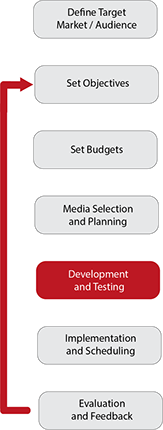
Once an appropriate advertising program has been selected, the actual development and testing of the program needs to be carefully monitored to ensure that the objectives
are fully achieved.
Implementation and Scheduling

Once the programme development has been completed, implementation and scheduling can then begin. In alignment with the communications calendar plan and product strategy, deployment can
take place in a timely manner.
Evaluation and Feedback
It is important to evaluate the effectiveness of any advertising and promotional activity...
Awareness Measures
Awareness Measures can be quantified by determining the percentage of the target market that is aware of your product and then establishing increases in awareness the coming periods. This is accomplished through primary research. Over time, you will be able to develop historical norms to help you to predict how increases in awareness translate to increases in active behaviour (purchases and sales).
Attitude Measures
Attitude Measures can be quantified by establishing goals for attitudinal shifts across key purchase attributes.
For example, if value is the most important target market purchase variable, you need to monitor shifts in the perception
of your product in terms of value.
Attitude Measures
Attitude Measures can be quantified by establishing goals for attitudinal shifts across key purchase attributes. For example, if value is the most important target market purchase variable, you need to monitor shifts in the perception
of your product in terms of value.
Advertising objectives should always be measure-able and specific and as such must relate to the expectations of the program itself. Evaluation should therefore, always be against the original set of objectives.
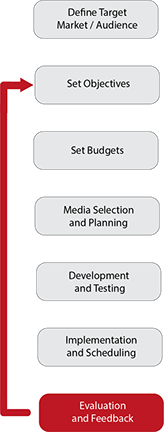
|Who Should Attend...
From a Product Management perspective the Marketing Audit is a key document to use in the
preparation of the business plan and input into other elements and processes.
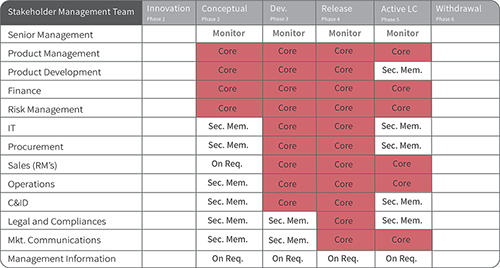
Workshop Tasks Algorithm (Generic) ...

Click to expand
Key / Definition:-
Monitor: Oversees the overall process, required to provide top level strategic objectives as required, performs a management role.
Core: Defines the ‘Core’ team headed (chaired) by the Product Manager required to attend the workshop in alignment with the ‘Product Phase’. Membership is mandatory.
Sec. Mem: Secondary Membership defines an ‘on-standby’ membership requirement and will depend upon the subject area, phase alignment and the project status. Membership is managed by the Product Manager.
On Req. : On Request membership defines a membership that is managed by the Product Manager.
|Related Procedures
The following interrelationship maps indicate; suggested content from other models/processes which may have influence or an effect on the analysis of the title process. The left-hand column indicates information or impact from the named process and the left-hand column indicates on completion of the process/analysis it may have an influence or effect on the listed processes.
Note: A complete set (professional quality) of PMM interrelationship cards are available to purchase - please contact us for further details.
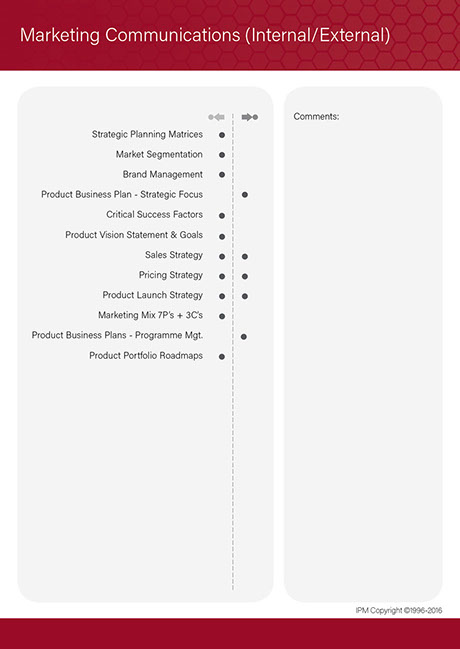
|Strategic Business Models, Workshop Tools & Professional Resources
PMM - Professional Support







